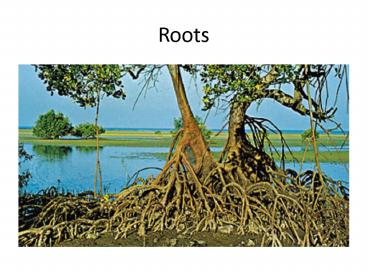Roots - PowerPoint PPT Presentation
Title:
Roots
Description:
Roots Roots Originally deemed the part of the plant that grew underground, but with the evolution of aerial roots (ones that grow above ground) and aerating roots ... – PowerPoint PPT presentation
Number of Views:115
Avg rating:3.0/5.0
Title: Roots
1
Roots
2
Roots
- Originally deemed the part of the plant that grew
underground, but with the evolution of aerial
roots (ones that grow above ground) and aerating
roots (ones that grow upward especially above
water), the definition has changed.
3
Roots
- The better definition of a root is the part of
the plant body that bears no leaves and therefore
has no nodes (places where branches come up).
4
Root Functions
- The major functions of roots are
- Anchor the plant
- 2) Absorb water and inorganic nutrients
5
Root Functions
- Roots also can act as storage organs for the
plant - They also enter into a symbiotic relationship
with fungi and/or bacteria in the soil in order
to obtain nutrients easier.
6
Root Morphology
- The tip of each root has a conical covering of
tissue known as the root cap. - Underneath the root cap lies the apical meristem,
which is the root region undergoing mitosis in
order to grow and push the root through the soil.
7
Root Morphology
- The outer surface of the root is known as the
epidermis. - The epidermis produces outgrowths known as root
hairs that increase the surface area for
absorption. - Root hairs typically only live a few days before
they are replaced by new ones.
8
Root Morphology
- Under the epidermis lies the cortex whose primary
role is starch storage. - The innermost layer of the cortex is the
endodermis (containing Casparian Strips) which
acts as a barrier to nutrients, preventing them
from passively entering the vascular tissue. - This allows the plant to accumulate lots of
minerals in its roots.
9
Root Morphology
- Inside the endodermis lies the vascular tissue.
- This is where water and nutrients start their
journey up the plant. - It is also an area of sugar movement or storage
depending on the environmental conditions.
10
Dicot Roots
11
Monocot Roots
12
Root Growth
- Roots will grow in the direction of the correct
oxygen, moisture and nutrient levels for plant
growth. - Primary growth is elongation whereas secondary
growth is an increase in diameter.
13
Root Systems
- There are two main types of root systems
- 1) Taproot system where there is a large primary
root with lots of smaller, secondary roots
emerging from it. It is found mostly in dicots
where starch storage is key.
14
Root Systems
- 2) Fibrous System where there is no primary root
and all roots are similar in size. They jut out
in all directions. Found commonly in monocots.
The main function is anchorage.
15
Monocot and Dicot Roots
16
Roots (below ground)
- The first structure to appear when a seed
germinates and is called the radicle in the
embryo. - The function of the root system is to absorb
water and nutrients from the soil for the growing
plant, as well as providing a stable anchor.
17
- Water is absorbed by a process called OSMOSIS
(Note Root cells are usually hypertonic to soil,
so water will enter the cells passively by
osmosis.) - The walls of root cells are very thin and have a
large surface area. - The depth of the root depends on the moisture
content of the soil.
18
General Structure
- Each root has a meristemic area near its tip to
allow for growth. - At the tip of each root is a cluster of cells
forming the root cap these cells produce a
mucus-like substance which lubricates the
movement of the root through the soil. - Root hairs increase surface area of the epidermis
increasing absorption of nutrients and water.
19
Some definitions
- Xylem a series of pipes running through the
roots, stems and leaves carrying water through
plant - Phloem carries food and dissolved materials
through plant - Vascular Cylinder central portion of a root
that contains the xylem and phloem
20
Monocot Roots
- fibrous roots (many branched roots of equal size)
- Examples grasses, grains, corn
- Cross Section
- - separate strands of xylem and phloem alternate
around a pith-like region
21
Monocot root
epidermis
Vascular Cylinder
cortex
xylem
phloem
pith/parenchyma
endodermis
22
Note the xylem and phloem in these differently
stained monocot roots.
23
Dicot Roots
- tap roots (1 large main root and smaller lateral
roots) - Examples carrots, beets, beans, dandelions, most
trees - Cross Section
- xylem is irregular and a solid strand
- phloem is arranged in separate strands
24
Dicot root
Vascular Cylinder
epidermis
cortex
phloem
xylem
NO pith/parenchyma
endodermis
25
Note the xylem and phloem in these differently
stained dicot roots.
26
More Definitions
- Epidermis - provides protection and regulates
water movement - - epidermal cells can elongate and form root
hairs which increase the surface area for water
absorption
27
- Cortex - the innermost layer of cortex cells is
called the endodermis - - the endodermal cells are coated with a waxy
layer called the casparian strip (this prevents
water from moving in the spaces between the
endodermal cells)
28
Lab Activity
- Look at monocot and dicot root slides using the
microscope. - Describe how to tell the difference between
monocot and dicot roots.
29
Home Fun?
- Read 558-563
- Describe
- a) cortex
- b) endodermis
- c) Casparian strip
- d) vascular cylinder
- e) pith/parenchyma
- Do P. 5634































